| Columns Retired Columns & Blogs |
Adcom GFA-7805 five-channel power amplifier Measurements
Sidebar 4: Measurements
Although the GFA-7805 is a five-channel amplifier, in general I measured pairs of channels at a time, with spot checks on the other channels. The Adcom is specified as being able to supply a maximum power of 300Wpc into 8 ohms with all channels driven. Before I performed any measurements, I performed the usual preconditioning by driving the amplifier (two channels only) at approximately 1/3 power (115W) into 8 ohms for an hour. (A solid-state amplifier with a conventional class-AB output stage undergoes the maximum thermal stress at 1/3 power.) Or rather, I drove the amplifier until it shut itself down to prevent damage from overheating, which happened 15 minutes into this period. (Note, in view of Kal's problem's with the Alphacore cables, that I used lengths of spaced-twin speaker cable, which has negligible capacitance.)
First, the fans mounted above the internal heatsinks switched on. Then, a few minutes later, the amplifier shut itself down, the grilles above the internal heatsinks way too hot to touch. After the amplifier had cooled down, it behaved normally, which indicates effective protection circuitry. However, while this preconditioning is very much a worst-case scenario for an amplifier, the shutdown also indicates that the GFA-7805 has insufficient heatsinking capability for such a high-powered design, particularly as I was driving only two of its five channels at the time. Those using the Adcom for concealed custom installations should make sure it has adequate ventilation.
Once the amplifier was running again, its behavior changed depending on whether I was driving the unbalanced or the balanced inputs. Both inputs were noninverting; however, the input impedance (at 1kHz) measured a high 94k ohms unbalanced but a lowish 10k ohms balanced. In addition, while the balanced input had a voltage gain (into 8 ohms) of 26.1dB, the unbalanced input was 3.5dB higher, at 29.6dB. On the positive side, the gains of the five channels matched to within 0.05dB, which implies excellent QA on Adcom's part.
The GA-7805's source impedance was superbly low, at 0.04-0.06 ohm. As a result, there was virtually no change in its audioband frequency response with differing load impedances. Fig.1 shows the Adcom's response driven by its balanced input jack into various loads. Its ultrasonic output can be seen to roll off slightly earlier with 2 ohms than 8 ohms, but the bandwidth is a wide -3dB at 160kHz. This results in a well-shaped 1kHz squarewave (fig.2), with the very slight slope to the leading edges of the waveform tops correlating with the minuscule downward slope seen in the fig.1 curves. There is a slight overshoot visible in this graph, so I repeated the test with a 10kHz squarewave, again using an 8 ohm load (fig.3). The overshoot is more pronounced, but nothing to be concerned about.
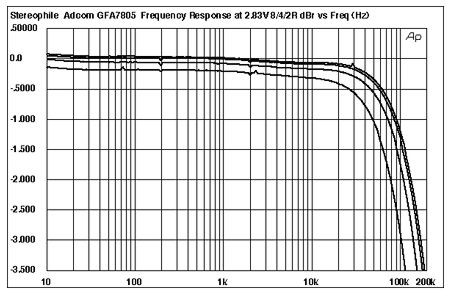
Fig.1 Adcom GFA-7805, balanced, frequency response at (from top to bottom at 2kHz): 2.83V into simulated loudspeaker load, 1W into 8 ohms, 2W into 4 ohms, 4W into 2 ohms (0.5dB/vertical div., right channel dashed).
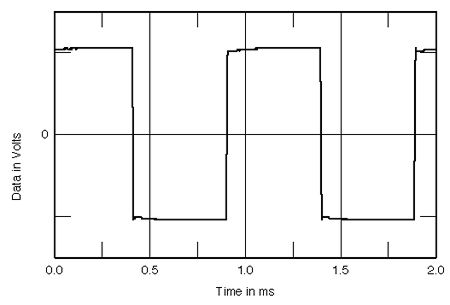
Fig.2 Adcom GFA-7805, balanced, small-signal 1kHz squarewave into 8 ohms.
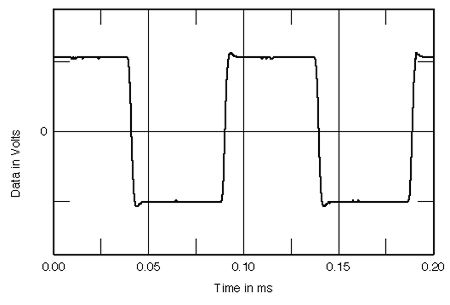
Fig.3 Adcom GFA-7805, balanced, small-signal 10kHz squarewave into 8 ohms.
So far, these tests had been done with the balanced input. When I repeated the response test with the unbalanced input, I got a very different result (fig.4). Now the ultrasonic response peaks up slightly into the higher impedances before rolling off. The extent of the peak is very mild, +0.1dB at 61kHz, but its existence does suggest that the amplifier may not be unconditionally stable when driven with single-ended signals.
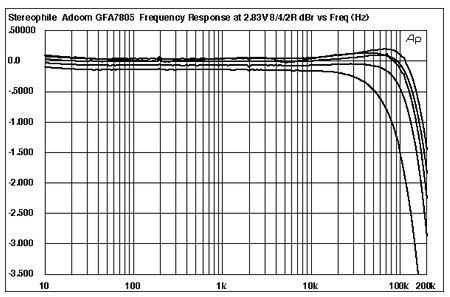
Fig.4 Adcom GFA-7805, unbalanced, frequency response at (from top to bottom at 2kHz): 2.83V into simulated loudspeaker load, 1W into 8 ohms, 2W into 4 ohms, 4W into 2 ohms (0.5dB/vertical div., right channel dashed).
Adjacent-channel crosstalk (not shown) was less than 100dB below 1kHz, increasing slightly with increasing frequency due to capacitive coupling. The '7805's signal/noise ratios were respectably high considering the high power available. The A-weighted figure with the input shorted was a high 92.5dB (ref. 1W into 8 ohms), this worsening to a still good 80.7dB, unweighted, wideband.
The Adcom is a very high-powered amplifier. Fig.5 shows how its measured THD+noise percentage changes with output power into loads ranging from 2 to 16 ohms. Specified at 300W into 8 ohms with five channels driven, it actually clipped at 398W into 8 ohms (26dBW), with very low distortion almost right up to the clipping point. The 4 ohm power was even higher, at 683W (25.3dBW). The 2 ohm trace in this graph stops short at 351W, at which point the protection circuit shut the amplifier down.
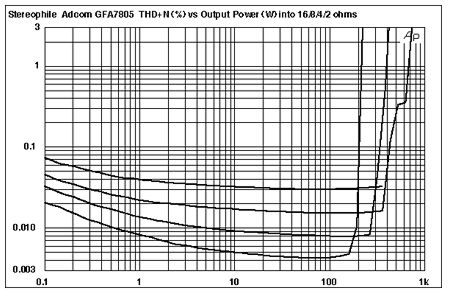
Fig.5 Adcom GFA-7805, distortion (%) vs 1kHz continuous output power into (from bottom to top): 16 ohms, 8 ohms, 4 ohms, 2 ohms (one channel driven).
Fig.6 shows how the amplifier's small-signal distortion+noise percentage changes with both frequency and with decreasing load impedance. It is respectably low overall, though the usual doubling with each halving of the load can be seen, as well as a slight rise above the audioband. (This graph is for balanced drive; with unbalanced drive the THD+N levels increased a little, especially in the top octaves, but with a maximum figure, into 2 ohms, of around 0.1%.) The notch at 120Hz in these curves is due to a residual 120Hz hum that I couldn't eliminate no matter how I arranged the grounding between the amplifier and my Audio Precision System One test set. However, as can be inferred from the S/N ratios, this hum is very low in level, and won't be audible with real-world speakers of normal sensitivities.
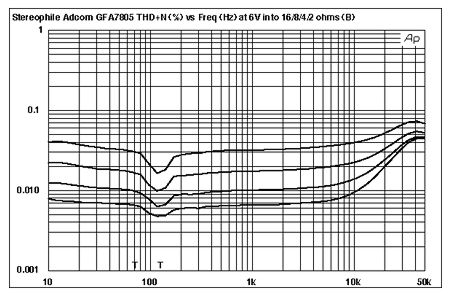
Fig.6 Adcom GFA-7805, balanced, THD+N (%) vs frequency (from bottom to top): 2.83V into 16 ohms, 8 ohms, 4 ohms, 2 ohms (right channel dashed).
The waveform of the Adcom's residual distortion is shown in fig.7. Even with 32 readings averaged to allow the harmonics to emerge from the background noise, the distortion is not much higher than the noise in this graph. Of more subjective importance, the distortion is primarily the benign second harmonic. This is confirmed by fig.8, which, taken at a much higher level, also shows some fourth and sixth harmonic present, each around the -90dB level (0.003%). In fact, the highest-level spurious tone in this graph is the 120Hz power-supply hum mentioned earlier, at -84dB (0.006%).
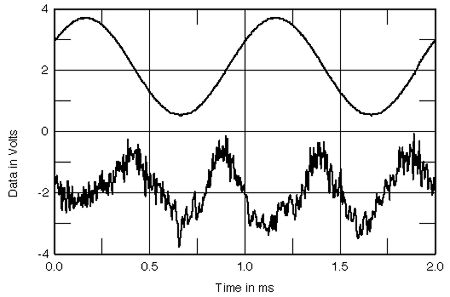
Fig.7 Adcom GFA-7805, 1kHz waveform at 20W into 4 ohms (top), 0.015% THD+N; distortion and noise waveform with fundamental notched out (bottom, not to scale).
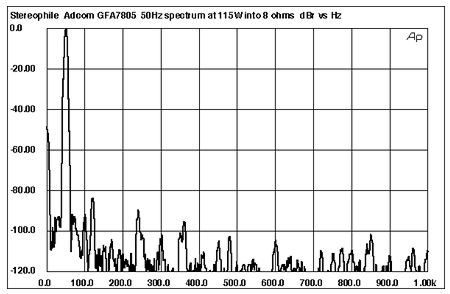
Fig.8 Adcom GFA-7805, balanced, spectrum of 50Hz sinewave, DC-1kHz, at 115W into 8 ohms (linear frequency scale).
The Adcom's intermodulation, however, was a little higher than the best amplifiers I have measured. An equal mix of 19 and 20kHz tones, with the GFA-7805 driven just below clipping into 8 ohms (fig.9), resulted in a 1kHz difference tone at -64dB (0.06%). This is still low in absolute terms.
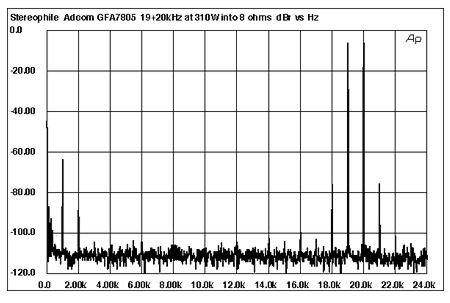
Fig.9 Adcom GFA-7805, balanced, HF intermodulation spectrum, DC-24kHz, 19+20kHz at 310W into 8 ohms (linear frequency scale).
The Adcom GFA-7805's measured performance suggests that its five high-power channels will probably work best when driven in balanced mode, while its heatsinking shortfall will not be a problem with multichannel music drive and normal playback volumes.—John Atkinson
- Log in or register to post comments




































